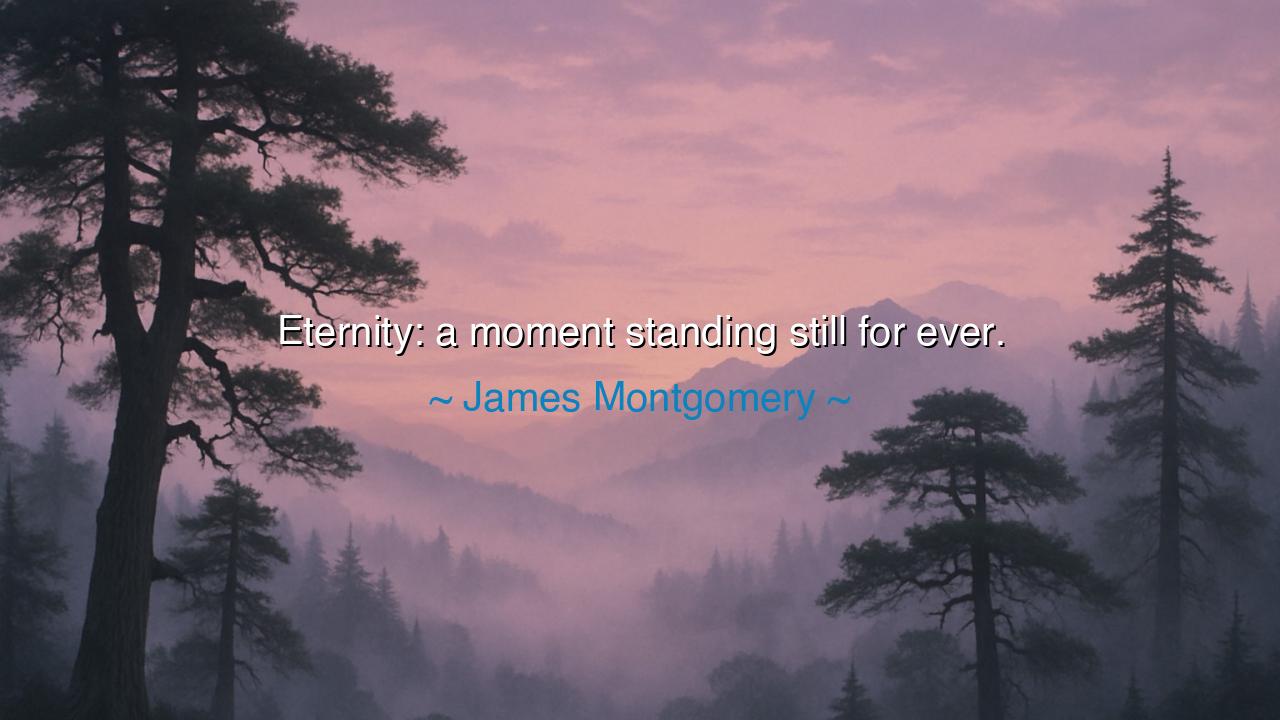
Eternity: a moment standing still for ever.






The poet and hymn-writer James Montgomery sought to capture the ungraspable when he wrote: “Eternity: a moment standing still for ever.” In this phrase is contained the paradox of human longing and divine mystery. For we, bound by the march of hours and the turning of seasons, hunger for that which is beyond time. Montgomery, a man of faith and lyric vision, sought to name what the ancients also sought—the place where time and timelessness meet, where the fleeting moment is not lost but preserved forever.
The origin of these words lies in Montgomery’s meditations on faith and the eternal. Living in the 18th and 19th centuries, a time of both scientific discovery and spiritual searching, he tried to reconcile the transience of human life with the promise of eternity. He saw that our most precious experiences—love, beauty, joy, awe—are but moments, and yet within them is a taste of the infinite. Thus he declared eternity not as endless years, but as a moment perfected, a present that does not pass.
The ancients themselves gave shape to this truth. The philosophers of Greece spoke of kairos, the “right moment,” distinct from chronos, the ticking of ordinary time. Kairos was the eternal breaking into the present, the divine pause when destiny revealed itself. So too did the mystics of many faiths speak of eternity as not only endless duration but timeless presence—the stillness at the heart of all change. Montgomery’s words echo these voices, casting eternity as the sanctification of a single moment.
History, too, bears witness. Consider the story of Archimedes, who, upon discovering the principle of displacement, leapt from his bath crying, “Eureka!” In that instant, time seemed to vanish; he was no longer bound to the passing of minutes but lifted into the eternal joy of discovery. Or think of lovers reunited after long separation—the moment of embrace becomes so full, so complete, that it feels as though the universe itself has stopped. Here we glimpse Montgomery’s vision: eternity is not elsewhere, but hidden within the intensity of the now.
The meaning of this teaching is profound: do not seek eternity only in the distant afterlife, nor imagine it only as a horizon beyond death. Eternity is present in the fullness of the moment. When we live with awareness, with love, with reverence, the fleeting becomes everlasting. A smile, a word of kindness, a sunrise over the sea—these are not lost, for they carry the weight of eternity within them.
Therefore, the lesson is clear: live not as one rushing through time, but as one who pauses to inhabit the eternal within the present. To the hurried soul, all is fleeting, all is dust. But to the attentive soul, even the smallest instant may reveal the face of forever. Eternity is not measured by length of days, but by depth of presence.
In practice, I counsel this: slow your steps, breathe deeply, and give yourself wholly to the moment before you. Whether at labor, in prayer, in love, or in solitude, seek to enter the stillness beneath the flow of time. Do not let your days pass in distraction, for the eternal hides in the simplest of things. In this way, you will taste eternity not as distant promise, but as living reality.
Thus, remember the wisdom of James Montgomery: eternity is a moment standing still for ever. Seek these moments, honor them, and they shall become the treasures of your soul, carried beyond time itself. For in truth, eternity is not far away—it is here, waiting for those with eyes to see.






AAdministratorAdministrator
Welcome, honored guests. Please leave a comment, we will respond soon